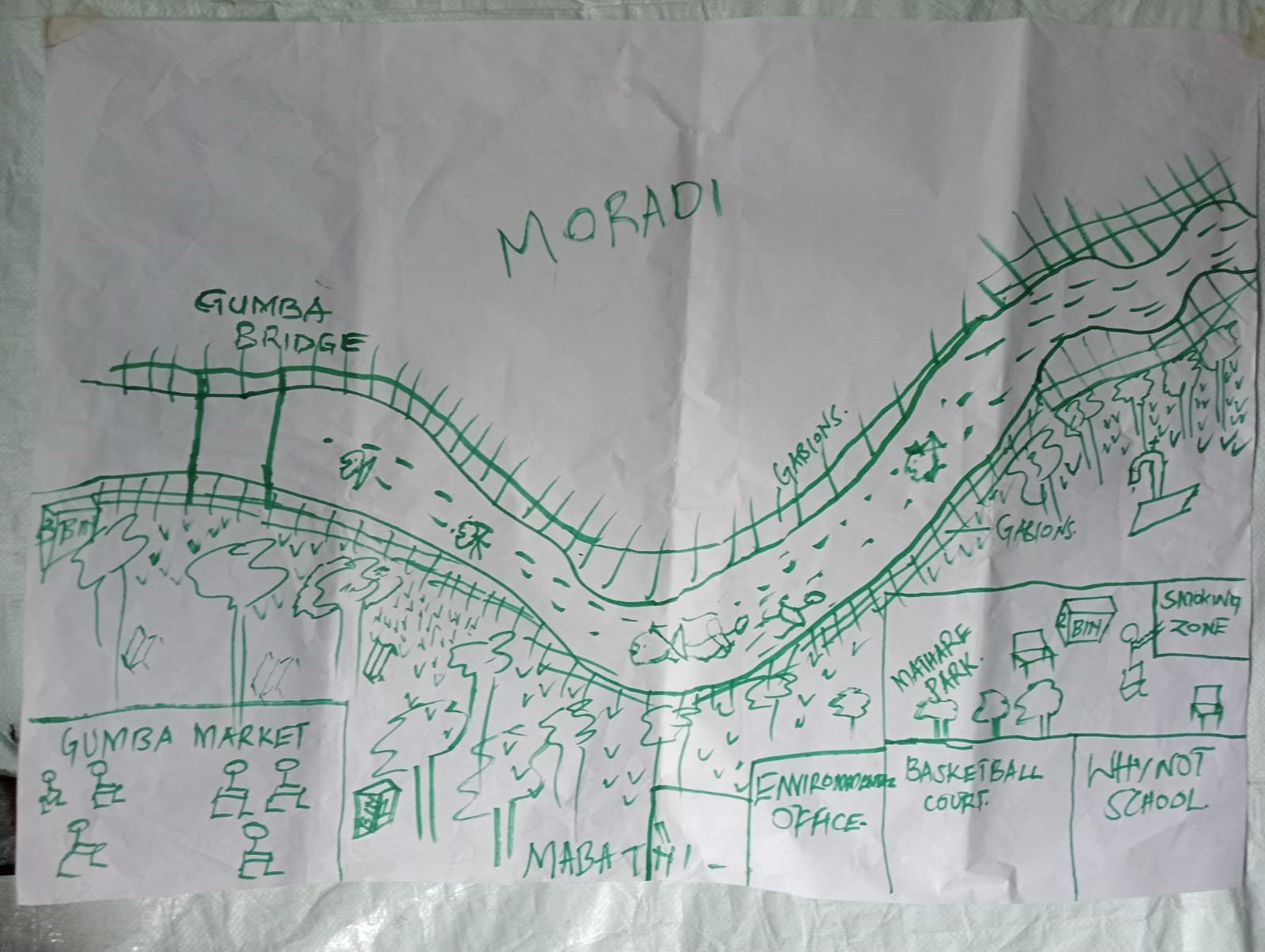Locally led ecological adaptation plan in Mathare and Ruaraka Sub-county.
By Elvira Songoro, Christine Wambui, Kilion Nyambuga, Stanley Mburu.
Caption: Digitized Youths Vision of Mathare river Ecosystem
In the early years, the four main rivers in Nairobi City County – Gitathuru, Mathare, Ngong, and Nairobi – served as sources of water for cooking, drinking, showering, and supported aquatic life. The thriving ecosystem led to pleasant weather, giving rise to the name Nairobi, derived from a Maasai phrase "Enkare Nairobi," which means a place of cool waters.
But is Nairobi really a place of cool water? Today, the experience of crossing or being around these rivers requires covering up the nose as you are welcomed by a foul smell from huge piles of garbage, fiscal waste, and discoloured water – sometimes black, green, blue, or brown depending on when you visit the rivers. Human activity has led to riparian degradation, resulting in the destruction of the ecosystem. This is caused by massive piles of solid waste, including pharmaceuticals, direct discharge of raw sewage from settlements encroaching on riparian areas, and industrial waste flowing into the rivers. Consequently, clean water scarcity has led to reliance on costly water vendors, loss of life due to floods, destruction of property, inconveniences such as school absenteeism, and health-related problems such as respiratory issues and cholera arising from the rivers' ecosystem.
Areas along the riparian have also turned into crime hotspots, where muggings occur, and aborted foetuses and babies are found.
To advance efforts on these issues and mitigate risks posed to those living along the riparian, Muungano wa Wanavijiji, SDI-Kenya, in collaboration with over 60 youth groups, including Ghettoh Farmers, Migingo Transformers, and Komb Green, have undertaken a deliberate approach called "The River Adoption Approach" on the 8.9 and 0.54 of Mathare and Gitathuru Rivers. The primary role of this approach is to unite these groups, create networks, establish recreational parks, advocate for the recognition of river-restoration groups as Nature-Based Solution (NBS) champions, award leases on the stretches they are restoring, and promote river adoption as an NBS strategy.
For meaningful and genuine engagement, Muungano wa Wanavijiji, through the Voices for Just Climate Action (VCA), has identified and mapped all the organized groups working on waste management, urban farming, landscaping, and beautification along the river in each ward. Ward-based community engagement forums have been conducted, where the youths participated in envisioning exercises and developed dream pictures for the river's transformation in the next two years. Their visions included riparian areas enriched with bamboo trees, footpaths, recreational parks, fish ponds, footbridges, gabions, and fruit trees. Several youth groups have already taken initiatives to negotiate with structure owners to move away from the riparian and have built gabions and green parks along the river.
Caption: Youths vision of mathare river drawn during the community consultative meetings
Also, capacity-strengthening programs have been initiated to address gaps such as financial management, bookkeeping, governance, conflict management, storytelling, and documentation. These skills are intended to equip the youth with a sustainable livelihood and support their efforts in regenerating the river. A new cadre of young activists now coordinates and convenes ward-level bi-weekly meetings to update and plan follow-up initiatives with the support of various civil society organizations (CSOs).
Despite facing eviction threats from structure owners and the political class, the river restoration groups have achieved some success stories, such as transforming areas destroyed by flooding into community parks. For instance, a memorial park has been established in a space where a seven-story building had previously sunk in Huruma, causing significant destruction and loss of lives. Additionally, some community members are voluntarily vacating areas to allow reclamation and transformation into parks, indicating that a just ecosystem transition can be achieved through the joint efforts of youths and community members working towards climate change solutions.
The youth have also engaged in urban farming, including poultry keeping, goat keeping, pig farming, crop, and hydroponic farming, which has become a major source of income for many to support their livelihoods. This initiative has also provided a pathway for some to reform their lives and break free from criminal activities, becoming better community members. Collaborating with the Local Administration and Police, they have planted numerous trees, including at police stations, as part of building relationships and reintegrating into the community. Additionally, the youth are actively sensitizing community members and offering solutions to climate change-related issues.
River adoption is not a new approach to ecosystem regeneration, as in 2015, the National Environmental Management Authority (NEMA) initiated the ADOPT-A-RIVER Initiative, which aimed to strengthen the link between climate change and addressing sustainability challenges in Kenya. However, if waste management issues remain unaddressed, then the efforts of restoring the river will leave to be a dream, and as my good professor says, "if the community does not dump in the river, they will dump in the streets." Efforts are underway to bring together waste pickers and city authorities through forums to tackle the waste management menace. Waste pickers have expressed the need for designated waste holding points and better coordination from the County Government's Department of Environment to prevent garbage disposal into the rivers. Community engagement meetings have spurred the need for the formation of a consortium comprising government, non-governmental, academia, and community members to co-develop a long-term solution for restoring Mathare and Gitathuru rivers.
The main solution to addressing the ecosystem of Mathare and Gitathuru rivers lies in social capital, as the community residing along these areas is well aware of the problems and potential solutions. "Muungano! Tushirikiane, Tushauriane" – Let us unite and collaborate to find solutions.


